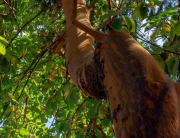Parents start a petition to change the name of George Jay Elementary School
›› Kate Wallace
A group of parents on the Parents Advisory Committee (PAC) of George Jay Elementary School are starting a petition to change the name of the school. Through research—based on the reference book Contesting White Supremacy: School Segregation, Anti-Racism and the Making of Chinese Canadians by Professor Timothy J. Stanley, PhD, Faculty of Education and Institute of Indigenous Research and Studies at the University of Ottawa—these parents believe that the man behind the school’s namesake, George Jay, is undeserving and unworthy of such iconic recognition.
In 1907, School Board Chair George Jay was a part of setting the groundwork to create a segregated school system in Victoria public schools. Chairman Jay helped develop a 1907 policy which stated that ‘no Chinese be admitted to the schools unless they know English sufficient to make them amenable to ordinary classroom discipline.’
In the summer of 1922, the Victoria School Board moved to segregate all racialized Chinese pupils. The segregation applied to all pupils of Chinese origin, including those who spoke English as their first—and in some cases only—language, and did not apply to other non-English speakers. Students were called out of their classes on the first day of school to be marched down to the segregated facilities. On September 6, 1922, the Chinese community of Victoria launched a Students’ Strike to protest this decision. The strike continued for the entire school year, with the pupils only returning to their former schools in September 1923.
A larger campaign was started by the Chinese Canadian Club, whose members tended to be the children of Chinese merchants and professionals. Racist immigration laws, especially the head tax of Chinese workers and their families, meant that there were few intact working-class Chinese families in Victoria. The claims of the segregationists that Chinese people were unable to learn English or Canadian ways were simply untrue. The Chinese Canadian Club—whose president was Joe Hope—invented the term ‘Chinese Canadian’ at a time when people thought that you could either be Chinese or Canadian, but not both.
In January 1922, Jay urged the board to return to its 1907 policy. Jay’s attitude is made clear by a February 1923 comment in the press: “The Board’s intention was to assist the Chinese as well as our children, giving them as special course of study.” Jay’s use of the word “our children” in this context reveals his xenophobic and exclusionary attitudes to Victoria’s Chinese population.
Jay supported segregation throughout his career, including when a partial system was first introduced in 1901. He was the main advocate over the long term for racial segregation. Other trustees and school officials opposed segregation at this time, which makes Jay’s beliefs especially egregious and not reflective of commonly held views of the period. Victoria-based teachers even offered to teach the striking pupils outside of school.
During the same era, the Vancouver School Board under the leadership of its municipal inspector and its board chair, rejected the creation of segregated schools (although it did have segregated classes for older Chinese and Japanese students who did not speak English).
There are many people who would be suitable to have the school named after. Joe Hope (Low Wong Joe), the founder of the Chinese Canadian Club and the chief organizer of the student strike, is an example of one. Because of Hope, we do not have racially segregated public schools in Canada today—no small accomplishment. The PAC has been in touch with the Songhees and Esquimalt Nations to discuss other possibilities for naming the school. Currently, the PAC has requested the School Board of Victoria to make a motion and to start a committee for furthering this important issue.
George Jay also had the audacity to name the school after himself, without consultation, memorializing himself for over a hundred years. Many in the current school community support the endeavour to change the school’s name so it better reflects its current spirit of inclusivity and respect. PAC President, Angela Cooper-Carmichael is leading the effort.
If you are interested in supporting this initiative please sign the petition at tinyurl.com/change-name-of-school.






